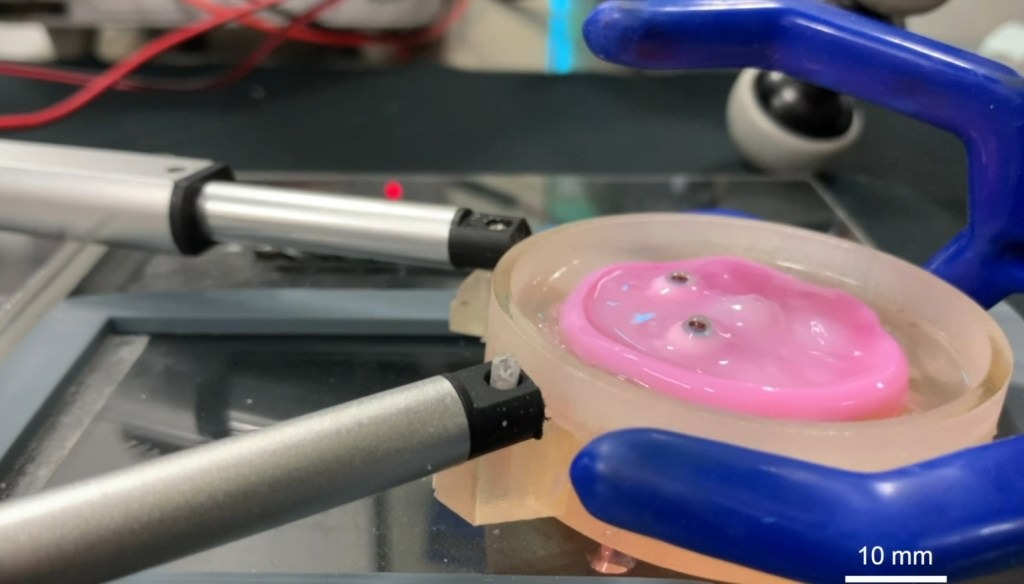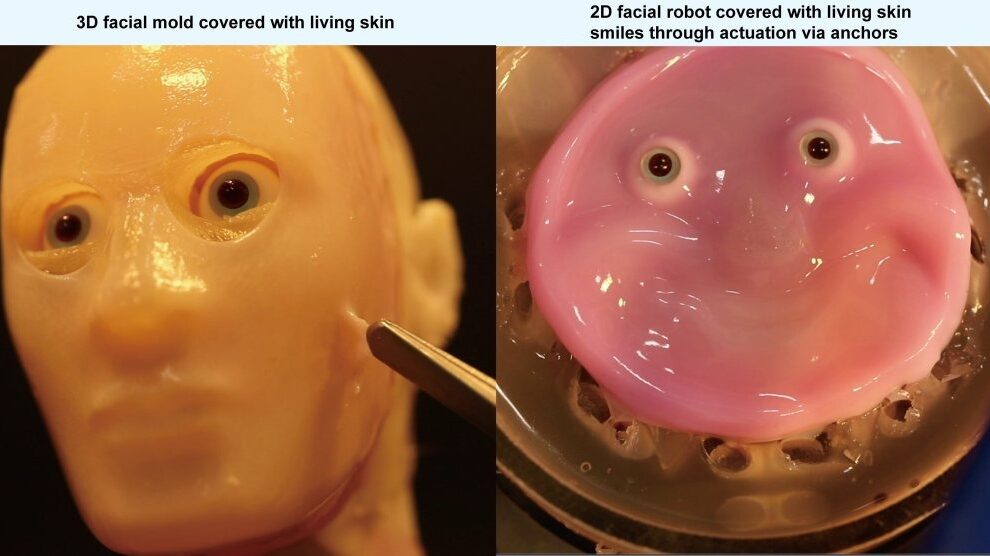In a groundbreaking development that sounds like it’s straight out of science fiction, researchers at the University of Tokyo have successfully created a robot face covered with living, lab-grown human skin cells. This remarkable achievement marks a significant leap forward in robotics and bioengineering, with far-reaching implications for various fields. Let’s delve into the details of this fascinating breakthrough and explore its potential applications and implications.

Bridging the Gap Between Artificial and Human
The creation of living skin for robots goes beyond mere aesthetics. This innovative approach aims to replicate not just the appearance but also some of the functional properties of human skin. Here’s what makes this development so exciting:
- Elasticity: The lab-grown skin mimics the flexibility and stretch of natural human skin, allowing for more realistic facial movements and expressions.
- Self-Repairing Capabilities: Like real skin, this living covering has the ability to heal itself when damaged, a crucial feature for long-term functionality.
- Realistic Texture and Appearance: The use of actual human skin cells results in a more natural look and feel compared to synthetic materials.
The Science Behind the Skin
The process of creating this living skin for robots is a marvel of bioengineering:
- Collagen Base: The skin is grown on a foundation of collagen, the protein that gives human skin its structure and elasticity.
- Anchoring Mechanism: Tiny perforations in the robot’s surface allow the skin to anchor itself securely, enabling movement without tearing.
- Cell Culture: Human skin cells are cultured and grown onto this structure, forming a living tissue layer.
This innovative approach allows for the creation of a more complex and functional skin-like covering than traditional synthetic materials could provide.
Potential Applications: Beyond the Uncanny Valley
The development of living skin for robots opens up a world of possibilities across various industries and applications:
1. Healthcare and Caregiving
More lifelike humanoid robots could revolutionize patient care, offering:
- Comforting presence for elderly care or pediatric patients
- Realistic training models for medical students
- Advanced prosthetics with natural-looking and functioning skin
2. Customer Service and Hospitality
Humanoid robots with realistic skin could enhance interactions in:
- Hotel receptions and concierge services
- Retail environments for personalized shopping assistance
- Information desks at airports or tourist attractions
3. Entertainment and Theme Parks
The technology could be used to create more immersive experiences:
- Lifelike animatronics for theme park attractions
- Advanced special effects in movies and television
- Interactive exhibits in museums and science centers
4. Prosthetics and Artificial Limbs
This technology could revolutionize the field of prosthetics by:
- Creating more natural-looking artificial limbs
- Potentially integrating sensory feedback capabilities
- Improving the psychological well-being of prosthetic users
5. Cosmetics and Skincare Research
The “face-on-a-chip” concept could transform product testing:
- Allowing for more ethical testing of cosmetics and skincare products
- Providing a more accurate model for studying skin reactions and treatments
- Potentially reducing the need for animal testing in the beauty industry
Challenges and Considerations
While the development of living skin for robots is undoubtedly exciting, it’s important to acknowledge the challenges and ethical considerations that come with this technology:
Technical Challenges
- Longevity: The long-term viability of living skin on non-living structures needs further study.
- Maintenance: Keeping the skin alive and functioning may require complex care and nutrients.
- Scalability: Moving from a small prototype to full-body coverage presents significant challenges.
Ethical Considerations
- Use of Human Cells: The ethical implications of using human skin cells for non-human entities need careful consideration.
- Uncanny Valley Effect: Highly realistic robots might provoke discomfort or unease in some people.
- Privacy and Consent: Questions about the source of skin cells and potential DNA implications need to be addressed.
The Road Ahead: Future Developments and Research
As exciting as this breakthrough is, it’s important to remember that we’re still in the early stages of this technology. The “smiling face” mentioned in the article is a basic prototype, and there’s much work to be done before we see widespread application of living skin on robots.
Future research directions might include:
- Integrating sensory capabilities into the skin, allowing robots to “feel” touch and temperature
- Developing methods for large-scale production of living skin for robots
- Exploring ways to combine this technology with artificial intelligence for more natural human-robot interactions
Conclusion: A New Frontier in Robotics and Bioengineering
The creation of living human skin for robots marks a significant milestone in the fields of robotics and bioengineering. It represents a fusion of artificial and biological technologies that could reshape our interactions with machines and our approach to healthcare, entertainment, and beyond.
While there are certainly challenges to overcome and ethical questions to address, the potential benefits of this technology are immense. From more empathetic caregiving robots to advanced prosthetics that look and feel more natural, the applications of this innovation could improve lives in numerous ways.
As we look to the future, it’s clear that the line between artificial and biological is becoming increasingly blurred. The development of living skin for robots is just one step in this fascinating journey of technological advancement. It’s an exciting time to be alive, watching as science fiction becomes science fact before our very eyes.










Add Comment